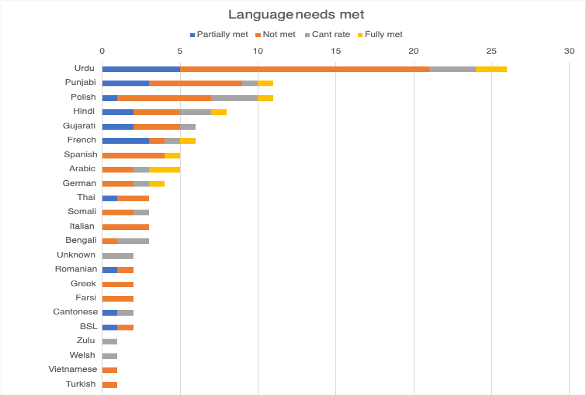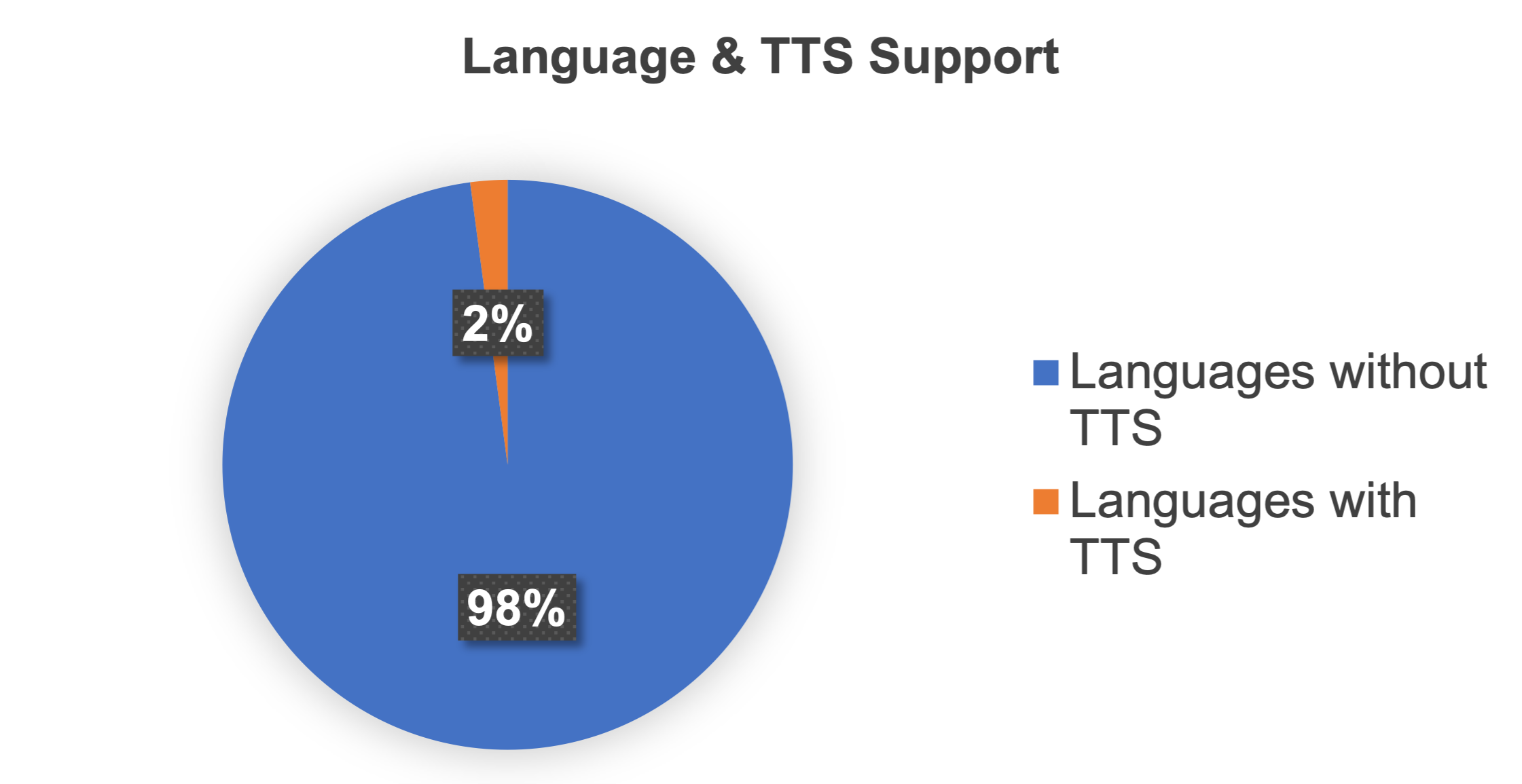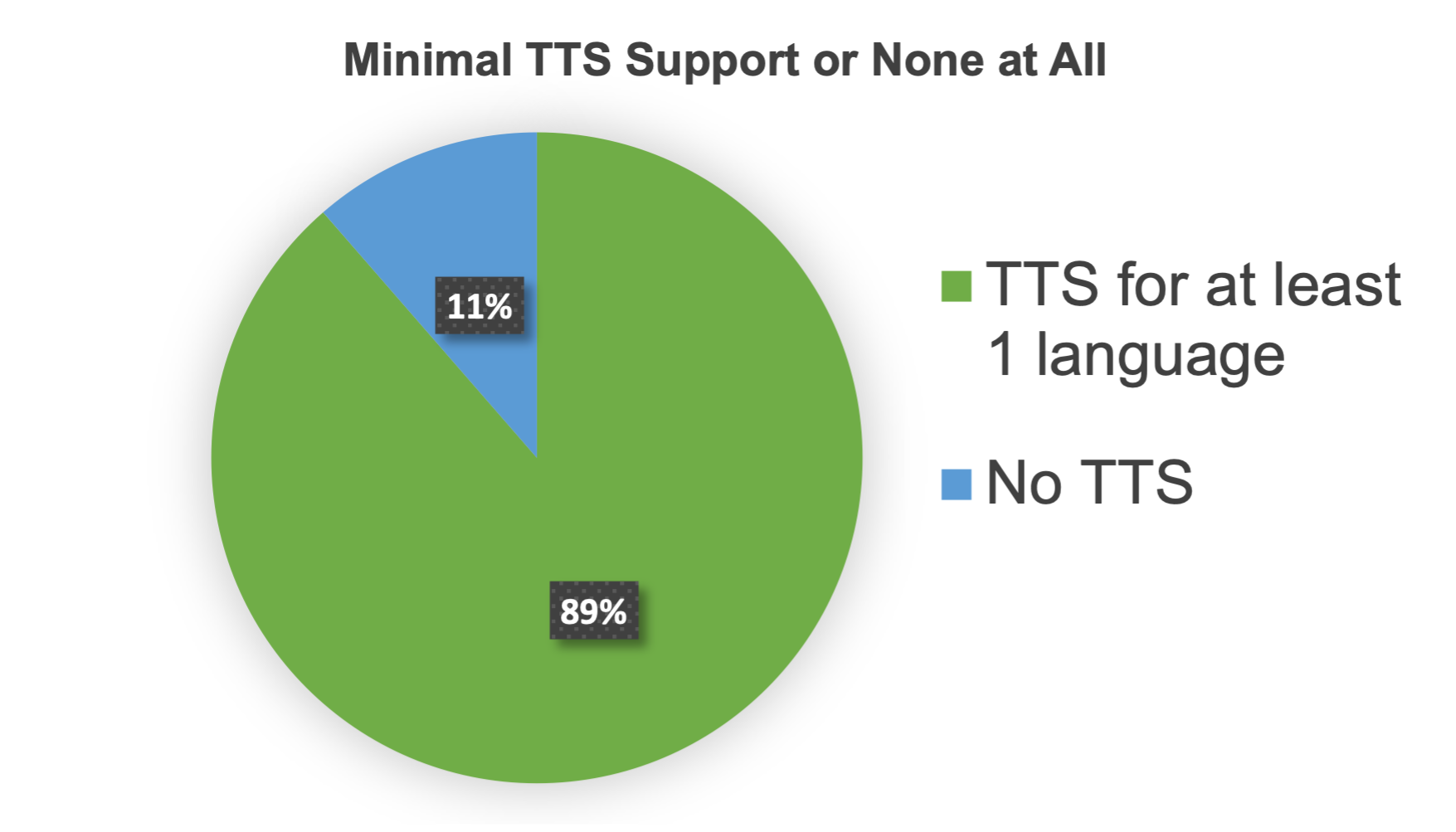TTS State of Play 2022
At Ace Centre, we support individuals in the UK and further afield with complex communication difficulties and we focus on Augmentative and Alternative Communication (AAC) and Assistive Technology (AT). We support many individuals who are multilingual or for whom English is a second language (see the chart below detailing the languages we support for Ace Centre NHS specialised clients). In this post we will be discussing the difficulties involved in supporting non-English speakers with current AAC technologies. Specifically, we aim to highlight the issue of online only supported languages for Text To Speech (TTS) systems. The limitations of online only TTS systems, within the global context of an already limited number of languages with TTS support and how this impacts our ability to provide the best accommodations to those in need of AAC.
Text to Speech Support Availability
How many languages are there in the world? Well, depending on your source it’s around 7100. (Note – some countries may have a language variant – e.g. if you are an English speaker, there might be English-North or English-Welsh (Speaking English with a Welsh accent). This is different from, say, a Portugese-Brazilian voice which would be deemed a different language) How many languages are supported by Text to Speech? 149. In other words, only 2% of the world’s languages have TTS support.
This dramatically low 2% figure is tempered by the fact that the world’s languages are not all utilised by an equal number of people. 89% of countries have at least one language with TTS support – or 11% of countries in the world have no access to TTS support for any of their languages. To identify where the lack of access to TTS support is felt, we need to look at the top 100 most used languages in the world. TTS is not supported for 53 of these top 100 languages. Over half of the top 100 languages not having support is an issue, as this translates into large swathes of Africans, Eastern Europeans, and Asians having no high-tech AAC solutions. The only solution for these populations is to voice record samples of speech from a donor – but this is far from ideal.
So, what happens when we add the trend towards online-only TTS support?
Traditionally, AAC on powered devices uses either synthetic, computer-generated speech from Text (Text To Speech – TTS) software or recorded speech from recordings of family members and friends. By far, most AAC software systems aim to support a TTS system.
Right now, most AAC software is either based on Windows, iOS or with a small amount on Android. On each of these platforms, a software developer has a choice:
- Use inbuilt Text To Speech software that is available to the operating system or
- Build in support to a commercial Text to Speech software which may be offline (e.g. Acapela) or online (e.g. Microsoft Cognitive Services/Azure, IBM Watson, Amazon Polly and Google).
A full list of companies providing TTS software:
| Name | Online/Offline |
| AT&T | Offline |
| eSpeak | Offline |
| Festival | Offline |
| ReadSpeaker (formally NeoSpeech) | Offline |
| Nuance Vocalizer | Offline |
| Google Cloud | Online |
| Nuance SVOX | |
| Praat | Offline |
| Nuance Loquendo | Offline |
| Ivona / Amazon Polly | Online |
| eKho (Chinese) | Offline |
| Cereproc | Offline |
| IBM Watson | Online |
| Acapella | Offline |
| Coqui | Offline |
| TTS-Microsoft-Azure | Online |
| AudioLM (google-research.github.io) | |
| MaryTTS | Offline |
| RHVoice | Offline |
| Voice Modelling / Banking | |
| Name | Online/Offline |
| VocalID | Offline |
| Cereproc Me | Offline |
| Acapela myOwnVoice | Offline |
| ModelTalker | Offline |
| Google Custom Voice | Online/Offline |
| SpeakUnique | Offline |
TTS systems are used for a wide range of software development needs. These include making content for voiceovers, announcements and automation solutions. AAC/AT developers are not the main focus for TTS, and in a lot of use cases, online systems work fine. As a result, there are now more languages supported online than offline – and these newer online voices are of better quality (91 Languages supported by an online voice compared with just 58 languages that have an offline voice).
Why is online-only TTS support a problem?
Most AAC users have limited online access, but continual TTS needs. Even if 24/7 internet access is not an issue, if the internet goes out, so does the AAC user’s TTS, and they need it working 100% of the time. Online-only systems do not meet the needs of AAC users in most cases.
At Ace Centre, as we address the needs of those who require a language with limited supports within AAC software, we are forced to feature match from a restricted or compromised field of AAC solutions that provide text-to-speech in the language we need. This can mean changing platforms and often changing the software we would have chosen for an individual to have the correct language, ideally with TTS which operates offline. In other words, online-only TTS support forces us to prioritize language access over other kinds of accommodations that various platforms and software may be able to offer those in need of AAC.
Take for example, a Welsh speaker; if you want a Welsh TTS system, what choice do you have? The first starting point is: Which TTS system has Welsh?
The Answer: Microsoft Azure (two voices) and Amazon Polly (one voice)
Click here to see a list of AAC and TTS systems offered
What AAC software supports these systems offline? None. What systems support it online? Well, one that we can identify: Coughdrop. But remember if you aren’t online, you can’t use your voice.
As you can see, the options become very limited, very quickly before we can even consider what systems might provide the best fit for an individual.
Click here to view and explore all data noted in this article
So, how do we solve?
In essence, there are three issues:
- Make all new TTS systems available to AAC software. This means working across Operating systems and software platforms.
- Finding ways for more online-only TTS to work offline.
- Supporting hard-to-reach languages that are not going to be commercially viable for companies to make voices or dialects and providing a toolchain for teams to create new voices
Ace Centre would like to invite all parties to meet to discuss this issue further and consider how we work together – developers and policymakers – to solve some of these problems. If you work for a large tech company, are a small independent developer working in the field of AT or are from a AAC company we would LOVE for you to be part of the solution and learn how to better support non-English speakers.
Please join us for a virtual roundtable discussion, information below:
Date: 18th January
Time: 1.30pm GMT
Location: Microsoft Teams
Teams link
Meeting ID: 380 293 157 485
Passcode: RMqrPq
Toll number: +44 20 4526 6279
Conference ID:
322 158 213#
Local Number: https://dialin.teams.microsoft.com/7829f575-1a89-44dd-bad9-cd515f59e14b?id=322158213
Reset Pin: https://dialin.teams.microsoft.com/usp/pstnconferencing





